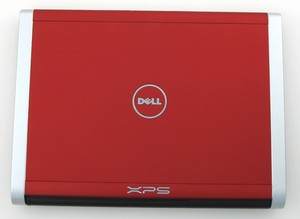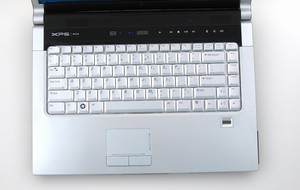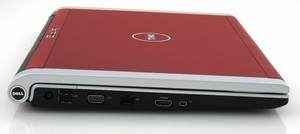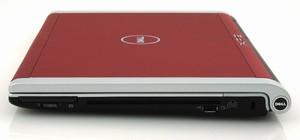Review of Dell XPS M1530
Review of Dell XPS M1530

The Dell XPS M1530 has the following specifications:
- 15.4-inch WXGA (1280 x 800) CCFL glossy screen
- "Crimson" red paint (also available in "Tuxedo" black or "Alpine" white)
- 2.2GHz Core 2 Duo T7500 processor, Santa Rosa chipset (up to 2.4GHz available)
- 2GB DDR2-667 SDRAM (up to 4GB DDR2 SDRAM available)
- 160GB 5400 RPM SATA HDD (32GB SSD drive available)
- Slot-loading dual-layer DVD±RW drive
- NVIDIA GeForce Go 8600M GT with 256MB GDDR3
- WWAN option for Verizon
- Ethernet, 802.11a/g/n (Intel 4965), Bluetooth option
- Integrated 2.0 megapixel webcam
- HDMI, VGA, S-Video, Firewire/1394, three USB 2.0 ports, integrated
- media reader (MS, SD, xD), fingerprint reader
- Media Center remote located in ExpressCard slot
- Windows Vista Home Premium
- Dimensions (with 6-cell battery): 14.06" x 10.34" x 0.93" - 1.38"
- Weight starts at 5.9 pounds with 6-cell battery (6.29 pounds with 9-cell)
Build and Design
The Dell, is very popular for making its customer happy with the design and performance of products. And XPS M1530 are really fullfilling its tradition.The main difference between M1330 and M1530 is its size.The design and look is mostly the same, the keyboard feels the same, the touch sensitive controls are replicated and for the most part the ports are the same (though you do get an extra USB 2.0 port on the M1530).
Screen
The M1530 is offered with only a standard 15.4" widescreen XGA (1280 x 800) display, while the XPS M1330 has the option for a thinner and more power efficient LED backlit display.The standard CCFL display is still gorgeously bright and flawless. Plus you get a higher 2.0MP web cam with the standard thicker CCFL screen, whereas with a thinner LED screen only a VGA resolution cam can be fitted.The horizontal viewing angles are really great.But the colors did begin to invert at lower viewing angles when the screen is tilted back.
Keyboard and Touchpad
The keyboard on the XPS M1530 is fairly similar to the XPS M1330, with obvious reasons. Its really being pleasure to work on M1530 laptop.The keyboard is firm with virtually no flex and the keys have excellent travel and cushion.
The touchpad works well enough, though it's seems a little on the small side given the size of the notebook. The mouse buttons have excellent travel and cushion, though I did feel like they made a bit too much of a "clicking" sound when pressed. The good news with the touchpad is that it's responsive, has dedicated scroll areas and the textured feel is good. A series of touch-sensitive media buttons with blue LED backlights are located above.

Ports and Features
Front profile view: Microphone in, dual headphone out, and memory card reader. (view large image)
Left side: DC power jack, two USB ports, VGA out, Ethernet/LAN, HDMI, and FireWire. (view large image)

Right side: ExpressCard slot, WiFi on/off, WiFi catcher, slot-loading optical drive, USB port, S-Video out, and Kensington lock slot. (view large image)

Back profile view of the XPS M1530: no ports here.
Speakers
The speaker quality was "acceptable" for a notebook but there isn't a built-in subwoofer.The speakers for the M1530 are located at the top of the keyboard area above the media buttons.The sound is little tinny when a littlebit louder comparing to other notebooks.
Heat and Noise
The fan moved a significant amount of hot air at very low noise.It wasn't noticeable over background noise most of the time. The noise at 53-56dB is recorded when the fan was at highest setting.
At last we can say that system fan and heatsinks in the M1530 do a great job managing heat when the system is under load.The temperature peaked at only 58 degrees Celsius during multiple 3DMark06 tests.
Unfortunately, noise was something of an issue with the M1530. The slot-loading optical drive was quite loud during Windows startup, inserting a disk, or ejecting a disk. The sound is something like a small power drill muffled under a pillow. That said, the optical drive produces acceptable noise levels when a disk is spinning in the drive.
The noise is a major issue. The hard drive noise was so loud that user is able to listen scratching noises from two feet away even while playing music at a resonable volume over the built-in speakers.
Comparison between M1530 and M1330
There are some notable differences other than size between the M1530 and M1330 however. The M1530 can be configured with a more powerful Nvidia 8600M GT graphics card for boosted gaming performance over the XPS M1330 that only offers up to the Nvidia 8400M GS. The M1530 also offers up to a 2.80GHz Intel T7800 processor, whereas the XPS M1330 tops out at an Intel T7500 2.2GHz processor. Obviously if you're all about the performance metrics and don't carry a laptop around much, the XPS M1530 is a better fit for you.
The XPS M1530 is way more eye catching in terms of design than the Inspiron 1520. The barrel hinge, dropdown screen and sloping look of the M1530 is just cool. Second, the XPS M1530 weighs just 5.9 lbs with a standard 6-cell battery and just 6 lbs and 4.6 ounces (6.29 lbs) with its 9-cell battery. The Inspiron 1520 weighs more than 7 lbs with the 6-cell battery. Other benefits of the XPS M1530 notebook include a sleeker slot loading optical drive, touch sensitive light-up buttons, dedicated XPS tech support, media remote control and thinner profile. The XPS M1530 is way more eye catching in terms of design than the Inspiron 1520. The barrel hinge, dropdown screen and sloping look of the M1530 is just cool. Second, the XPS M1530 weighs just 5.9 lbs with a standard 6-cell battery and just 6 lbs and 4.6 ounces (6.29 lbs) with its 9-cell battery. The Inspiron 1520 weighs more than 7 lbs with the 6-cell battery. Other benefits of the XPS M1530 notebook include a sleeker slot loading optical drive, touch sensitive light-up buttons, dedicated XPS tech support, media remote control and thinner profile.
Conclusion
While this is certainly the hottest 15.4" notebook available from Dell,but the user who have worked at M1330 doesn't admire its designing features.
While issues like a noisy slot-loading drive, noisy hard drive, and limited screen options will make some demanding buyers look elsewhere, the M1530 is an excellent alternative to HP's popular dv6500t notebook in the same price range.
Pros
- Reasonable battery life
- Nice keyboard, touchpad and media buttons
Thin and light
Cons
- Slot-loading drive is loud during loading and ejecting
- Hard drive noise is magnified by the case/mount design
- Limited screen options at the time of this writing
- There are only three UPS ports